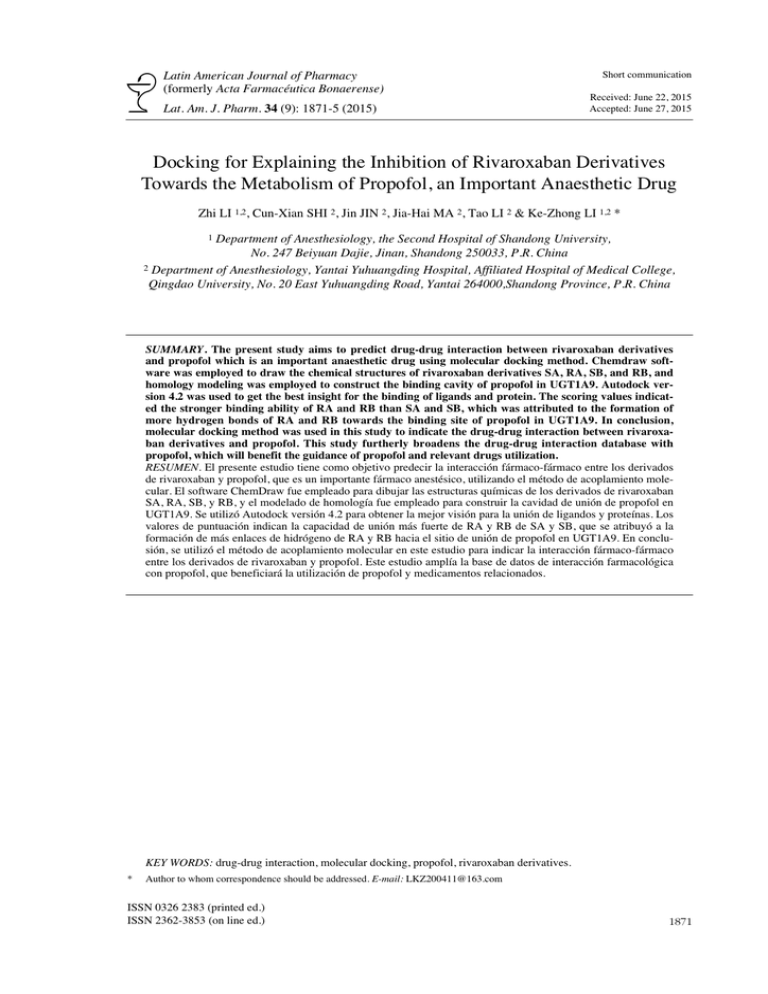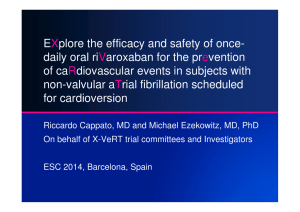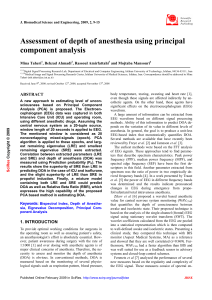Docking for Explaining the Inhibition of Rivaroxaban Derivatives
Anuncio

Latin American Journal of Pharmacy (formerly Acta Farmacéutica Bonaerense) Lat. Am. J. Pharm. 34 (9): 1871-5 (2015) Short communication Received: June 22, 2015 Accepted: June 27, 2015 Docking for Explaining the Inhibition of Rivaroxaban Derivatives Towards the Metabolism of Propofol, an Important Anaesthetic Drug Zhi LI 1,2, Cun-Xian SHI 2, Jin JIN 2, Jia-Hai MA 2, Tao LI 2 & Ke-Zhong LI 1,2 * Department of Anesthesiology, the Second Hospital of Shandong University, No. 247 Beiyuan Dajie, Jinan, Shandong 250033, P.R. China 2 Department of Anesthesiology, Yantai Yuhuangding Hospital, Affiliated Hospital of Medical College, Qingdao University, No. 20 East Yuhuangding Road, Yantai 264000,Shandong Province, P.R. China 1 SUMMARY. The present study aims to predict drug-drug interaction between rivaroxaban derivatives and propofol which is an important anaesthetic drug using molecular docking method. Chemdraw software was employed to draw the chemical structures of rivaroxaban derivatives SA, RA, SB, and RB, and homology modeling was employed to construct the binding cavity of propofol in UGT1A9. Autodock version 4.2 was used to get the best insight for the binding of ligands and protein. The scoring values indicated the stronger binding ability of RA and RB than SA and SB, which was attributed to the formation of more hydrogen bonds of RA and RB towards the binding site of propofol in UGT1A9. In conclusion, molecular docking method was used in this study to indicate the drug-drug interaction between rivaroxaban derivatives and propofol. This study furtherly broadens the drug-drug interaction database with propofol, which will benefit the guidance of propofol and relevant drugs utilization. RESUMEN. El presente estudio tiene como objetivo predecir la interacción fármaco-fármaco entre los derivados de rivaroxaban y propofol, que es un importante fármaco anestésico, utilizando el método de acoplamiento molecular. El software ChemDraw fue empleado para dibujar las estructuras químicas de los derivados de rivaroxaban SA, RA, SB, y RB, y el modelado de homología fue empleado para construir la cavidad de unión de propofol en UGT1A9. Se utilizó Autodock versión 4.2 para obtener la mejor visión para la unión de ligandos y proteínas. Los valores de puntuación indican la capacidad de unión más fuerte de RA y RB de SA y SB, que se atribuyó a la formación de más enlaces de hidrógeno de RA y RB hacia el sitio de unión de propofol en UGT1A9. En conclusión, se utilizó el método de acoplamiento molecular en este estudio para indicar la interacción fármaco-fármaco entre los derivados de rivaroxaban y propofol. Este estudio amplía la base de datos de interacción farmacológica con propofol, que beneficiará la utilización de propofol y medicamentos relacionados. KEY WORDS: drug-drug interaction, molecular docking, propofol, rivaroxaban derivatives. * Author to whom correspondence should be addressed. E-mail: [email protected] ISSN 0326 2383 (printed ed.) ISSN 2362-3853 (on line ed.) 1871

